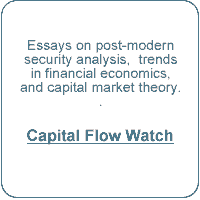Essay on Stock Valuation and Investment Theory
Mr. Clendenin's Suggestion
What men have seen they know;
But what shall come hereafter
No man before the event can see,
Nor what end waits for him.
John Burr Williams’ formula for the discounted present value of a stream of dividends is a useful starting point in equity valuation, despite the indeterminate nature of the calculation.
In 1957, John Clendenin wrote an article in Trusts and Estates Magazine entitled, 'Dividend Growth as Determinant of Common Stock Values'. Noting the uncertainty involved in trying to predict the future stream of dividends, Clendenin suggested the discount rate should be increased for dividend streams further removed in time.
Dividends further away in time should have a greater discount
To explain his idea, he gave an example of a company that paid yearly dividends of one dollar, saying that these dividends would grow six percent a year for twenty years, with no growth for the next eighty years.
He proposed that dividends for the first decade be discounted at four percent, and at five percent for the second decade, six percent for the third decade, and seven percent for the remaining seventy years.
Based on these assumptions, he calculated the present value of the dividend stream, as shown in this table adapted from his article:
Because the first decade was discounted at four percent, we may assume this was the investor’s long-term target return and that greater discounts for distant decades represented greater uncertainty.
We also may presume the corporation had bonds with a current yield of, say, three percent and that dividend pay-out was fifty percent of earnings. This would mean that this growth stock, valued at $ 35.53, had a current dividend yield of 2.8% and a price-earnings ratio of about seventeen.
This would be typical pricing for a growth stock of that period. (We need not agree with the assumptions in Mr. Clendenin’s example to gain useful insights about John Burr Williams’ equations.)
Valuing Less the Far than the Near
If the directors of Clendenin’s hypothetical company decide not to pay dividends for thirty years, but instead distribute earnings as buybacks linked to executive stock options, the value of the stock would be only $ 5.96 – the discounted value of dividends in the last seven decades.
This case would resemble many non-dividend-paying growth stocks during the Great Bubble of the 1990s, suggesting that non-dividend-paying growth stocks were probably vastly overvalued.
If the company pays dividends at first, but stops after ten years, using earnings for stock options and buybacks to reward executives, the value of the stock would be only $ 10.85, the discounted value of dividends in the first decade.
In 1957, few expected that companies would prefer stock options and buybacks over dividends
Therefore, company policy for dividend payout, stock options, and buybacks is important in valuing a stock.
In 1957, when John Clendenin wrote this article, few people would have predicted that many companies would abandon dividends in favor of stock options and buybacks – or that investors would be so gullible as to stand for this.
Whatever the business of the company in the example, there was no way for someone in 1957 (when Mr. Clendenin’s article was published) to forecast dividends for the years 1987 to 2057.
So, why should we give value to dividends in the distant future, especially when a company has no duty to pay dividends at all?
It may be that a person who bought this stock in 1957 at $ 35.53 later sold at a handsome profit in the bull market of the 1990s, but this begs the point. This would be profit gained by selling to Mr. Greater Fool, not a profit drawn from the intrinsic value of the security itself.
Valuing Future Market Levels
Few people, if any, invest in common stocks for one hundred years.
The average tenure of a retirement plan is from twenty to thirty years. With bonds, the investor can 'ladder' a portfolio so that some instruments come due each year when he or she needs the money.
There is a credit risk on the bonds, but market risk can be controlled by spreading maturities to match the need for cash.
Stock investors must eventually sell out to Mr. Greater Fool
However, since stocks have no maturity, laddering is not possible.
The investor must sell stock to Mr. Greater Fool if he wants to get his money back.
Thus, Mr. Dividend assumes, in part, the personality of Mr. Lesser Fool when he uses common stocks for his retirement plan.
From Williams’ equation for stock value, we see that part of the price that Mr. Dividend pays for a growth stock represents value received only by selling the stock after twenty or thirty years.
The doubt associated with this future sale suggests that Mr. Dividend should pay little for any dividend stream beyond the period he intends to hold the stock.

